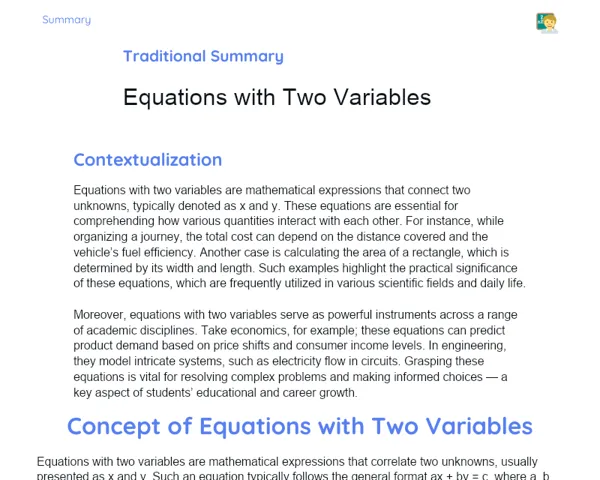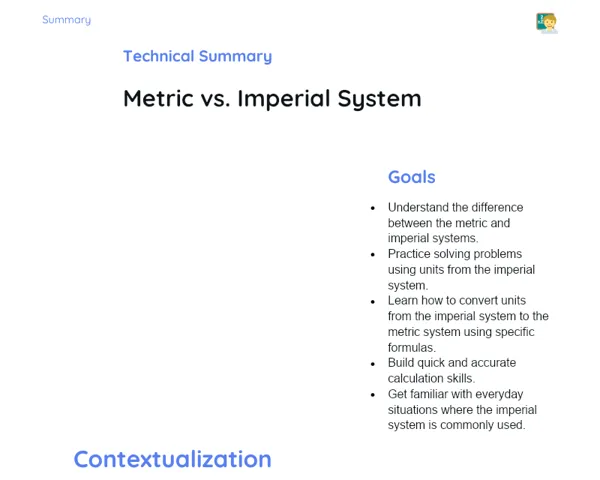Summary Tradisional | Spatial Geometry: Volume of the Pyramid
Contextualization
Spatial geometry is an extension of the plane geometry we studied earlier. While plane geometry deals with two-dimensional shapes such as triangles, squares, and circles, spatial geometry focuses on three-dimensional figures like cubes, cylinders, spheres, and pyramids. Having a good grasp of these shapes and their properties is essential for many practical applications including construction, architecture, and engineering.
In this topic, pyramids are given special attention because of their unique structure and interesting mathematical properties. A pyramid is a solid figure that has a polygonal base with triangular faces meeting at a common point called the vertex. Learning how to calculate the volume of a pyramid is important as it tells us how much space the pyramid occupies, a skill that is particularly useful in planning and building structures.
To Remember!
Pyramid Volume Formula
The volume of a pyramid is given by the formula V = (Base Area * Height) / 3. This is derived by comparing the pyramid to a prism that has the same base and height; the volume of the prism is simply the product of the base area and height, and the pyramid occupies exactly one-third of that volume.
The calculation hinges on accurately determining the base area, which varies depending on the shape of the pyramid’s base. For example, if the base is a square, its area is found by squaring the side length, and if the base is a triangle, the area is computed as (base * height) / 2.
It is also important to note that the height in the formula refers to the perpendicular distance from the base to the vertex of the pyramid. Do not mix this up with the slant, or lateral, height of the triangular faces.
-
The pyramid volume formula is V = (Base Area * Height) / 3.
-
The base area calculation changes depending on the shape of the pyramid's base.
-
The height used in the formula must be the perpendicular height from the base to the vertex.
Identifying the Base and Height
It is crucial to correctly identify the base and height of a pyramid when applying the volume formula. The base is the polygon where all the triangular faces join. Depending on the pyramid, the base could be a triangle, square, pentagon, and so on, each requiring its own method to calculate the area.
The height of the pyramid is the perpendicular line drawn from the centre of the base to the vertex where all the faces converge. In some cases, the height is visibly contained within the pyramid, but sometimes you may need to imagine a perpendicular line from the base to identify it properly. Always ensure that you use the perpendicular height and not the lateral height along the triangular face.
-
The base of the pyramid is the polygon where the triangular faces meet.
-
The height is the perpendicular line from the centre of the base to the vertex.
-
The lateral height should not be used in the volume calculation.
Calculating the Base Area
Calculating the area of the base of a pyramid depends on the specific geometric shape of the base. For a square base, the area is found by squaring the length of its side. For a triangular base, the area is (base * height) / 2. For other regular polygons like pentagons or hexagons, you might need to use formulas involving the perimeter and the apothem to determine the area accurately.
For instance, the area of a regular hexagon can be calculated with the formula (Perimeter * Apothem) / 2, where the perimeter is the sum of all sides and the apothem is the distance from the centre of the hexagon to the midpoint of one of its sides. Getting the base area right is critical, as any error here will lead to an incorrect calculation of the pyramid’s volume.
-
The formula for the base area depends on the geometric shape of the base.
-
For a square base, the area is side squared.
-
For a triangular base, the area is (base * height) / 2.
-
For regular polygons, the area may be calculated using the perimeter and the apothem.
Practical Application of the Formula
To apply the pyramid volume formula in practice, follow these steps: first, determine the shape of the base and calculate its area using the appropriate formula; then, identify the perpendicular height of the pyramid. Multiply the base area by this height and finally divide the result by three to obtain the volume.
For example, if you have a pyramid with a square base where each side measures 6 cm and the height is 10 cm, first compute the base area as 6 cm x 6 cm = 36 cm². Multiplying by the height gives 36 cm² x 10 cm = 360 cm³, and dividing by three results in a volume of 120 cm³. This method can be applied to pyramids with various base shapes and dimensions.
Practicing with different problems, including those with irregular bases and varying heights, reinforces understanding and builds the skill to apply the formula accurately, whether in architectural designs or engineering projects.
-
To apply the formula, first calculate the base area and identify the perpendicular height.
-
Multiply the base area by the height, then divide by three to get the volume.
-
Practicing with different shapes and heights helps solidify your understanding.
Key Terms
-
Spatial Geometry: A branch of mathematics that deals with three-dimensional shapes.
-
Pyramid: A three-dimensional solid having a polygonal base with triangular faces meeting at a single point.
-
Volume: The measure of space occupied by a three-dimensional object.
-
Base Area: The area of the polygon forming the base of the pyramid.
-
Pyramid Height: The perpendicular distance from the base to the vertex of the pyramid.
-
Lateral Height: The distance along the face from the base to the vertex, not used in volume calculations.
-
Apothem: The distance from the centre of a regular polygon to the midpoint of one of its sides.
-
Perimeter: The sum of the lengths of all sides of a polygon.
Important Conclusions
In this lesson, we delved into spatial geometry, focusing on how to calculate the volume of pyramids. We learnt to apply the formula V = (Base Area * Height) / 3 by correctly identifying the base and perpendicular height in different pyramids. We also went through methods to calculate the area of various base shapes – from simple squares and triangles to more complex polygons like regular hexagons.
We practiced applying the formula through various examples and discussed common mistakes such as mixing up the perpendicular height with the lateral height. With these tips and thorough practice, the concepts become much clearer.
This topic is not only important in mathematics but also beneficial in practical areas like architecture and engineering where accurate volume calculations are essential. Mastering these skills helps in developing critical and analytical thinking, which is invaluable in many professional and everyday problems.
Study Tips
-
Revisit the concepts of calculating areas for different geometric shapes. A strong foundation in area calculation is crucial for correct volume computations.
-
Practice with a range of problems involving various pyramid bases and heights. Increased practice builds confidence in identifying and applying the right formulas.
-
Explore real-world applications in fields such as architecture and engineering to appreciate the practical importance of volume calculations.



